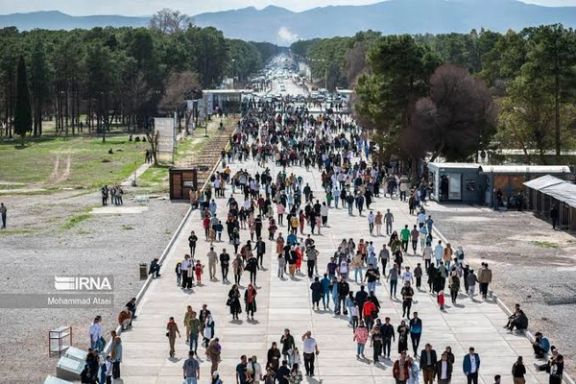Iranians Celebrate Norouz At Secular Sites Amid Mosque Closures

This year, the Islamic month of Ramadan coincided with the ancient Persian celebration of New Year (Norouz). Urged by authorities to follow fasting traditions, Iranians were asked not to travel during Ramadan.
But, despite these calls, the Iranian populace took advantage of the one-week Norouz holiday, starting on March 20, and visited the country’s ancient and cherished national monuments.
Authorities reported a staggering 2.8 million Iranians flocking to the nation's museums and historical sites during the New Year holidays.
Among these destinations, the tomb of the revered Persian poet Hafez in Shiraz witnessed the most substantial influx, attracting approximately 200,000 visitors. The ancient city of Persepolis received approximately 140,000 visitors, while the historic royal complex of Sa’dabad Palace in Tehran welcomed around 75,000 visitors.
Pictures and videos showcasing the 5-kilometer queue of cars entering Persepolis, along with the sizable gathering of Iranians at the nearby ancient archaeological site of Naqsh-e Rostam, circulated on local websites.

Some estimates suggest nearly 10,000 people were in Persepolis and 30,000 people at the tomb of Hafez to mark the exact moment of the Spring equinox – marking the beginning of the new year. In several provinces people gathered around traditional bonfires to dance and sing and celebrate.
On the flip side, a senior Iranian cleric has reported that two-thirds of the country's 75,000 mosques have been shut down.
The mosques of major cities may attract a small crowd during communal prayers – only at one time of the day. Morning and afternoon prayers are often not held. During the month of Ramadan, mosques in Muslim-majority countries typically witness a surge in attendance.
But, in Iran prayers have retreated to the privacy of people’s homes – reflecting a trend where people prefer not to show off their religiosity.
Notably, the list of the most visited places doesn't even include iconic and breathtaking mosques such as the Amir Chakhmaq Mosque in Yazd or the Shah Mosque in Esfahan.
While government propaganda outlets claim 5 million pilgrims entered Khorasan Razavi province, no photographic evidence depicting these purported millions of people or the vehicles transporting them have been published.
This figure is misleading as it implies that all those entering Khorasan Razavi province are pilgrims, whereas many visit the province to reunite with family rather than for pilgrimage. The photos accompanying these reports depict tens of thousands of pilgrims, not millions as claimed.
Three competing visions
What vision does the above social trend draw for the future of Iran? In what direction is the country heading? Despite enduring political and social upheavals, the main highways shaping Iran's future trajectory are rooted in Iran-centered nationalism, Islamism, and ethnocentrism.
None of these three can be eliminated, yet current developments vividly illustrate the path of nationalism over the other two.
Even religious reformers no longer believe that Islamism will remain the dominant vision. Ethnocentrism is present but not dominant. However, Iran-centric nationalism, once marginalized during the dominance of Islam-oriented discourse from the 1980s to the 2000s, has emerged as a serious and formidable contender against both Islam-oriented and ethnocentric perspectives in recent years.
Among these three paths, the Islam-centered one has been thoroughly explored in the past, with its failures and disastrous outcomes evident for Iranians to see clearly. The effort of the Islamists was to realize this path in such a way that no one in Iran could even think of the other two. The Islamists wanted to build their ideal society without a rival by realizing religious totalitarianism and stopping the resistance of Iranian citizens against repressive and Islamist-oriented social engineering.
The Iran-centered roadmap was implemented over five decades by a group of patriotic people during the Pahlavi era and brought Iran security, prosperity, development, tolerance, and credibility in the world.
The only unexplored path remaining is ethnocentrism. The challenge with this approach is that, aside from advocating for self-government and local rule, it has not put forth a comprehensive vision for the nation-state. For this reason, individuals who do not align with the framework of ethnicities or have moved beyond ethnic affiliations do not see this vision as their salvation.
Since 2018, the Islam-oriented and ethno-oriented perspectives have not appeared much even in the scene of public protests. The slogan "Fundamentalist, reformist! It's over" – which permeated the political landscape of the country and was even somewhat echoed by politicians of the Islamic Republic in various forms – marked a pivotal moment in the decline of the Islam-oriented path in the nation. The ruling Islamists even beat the drum of military ambitions and missiles more than the elements of the Islam-oriented path. By using the combination of "Iranian-Islamic" for their programs, they attempt to make it Iran-centric. However, the Sharia-centric path and the lifestyle of the Shia clergy are so central in their programs that they leave no room for Iran.
Nationalist or patriotic movements, which the left falsely identifies as fascist and racist, are gaining momentum worldwide. They seek to liberate their nations from the influence of indoctrination, radical ideologies, identity politics, anarchism, and cultural relativism – ideologies that threaten the decline of Western civilization. Today, Iranian nationalism is focused on the salvation of Iran by eliminating Islamist policies.
Due to its compatibility with the lifestyle of the majority, social tolerance, development-oriented approach, and openness to the West, the Iran-centered path has garnered the greatest support from the common people in the streets and markets.
The slogan "Reza Shah, Rest in Peace" used in street protests, invoking the memory of the first King of the Pahlavi dynasty in Iran, effectively encapsulates this vision.